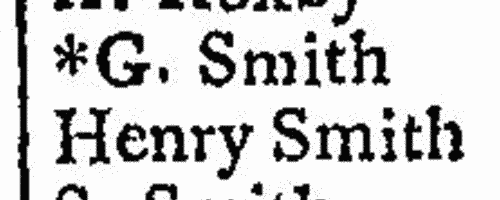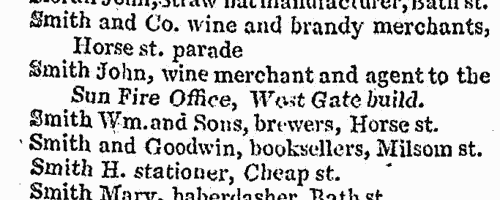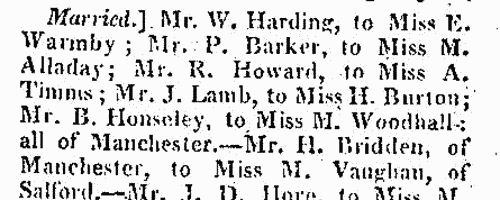Add this eBook to your basket to receive access to all 50 records. Our indexes include entries for the spelling langstone. In the period you have requested, we have the following 50 records (displaying 21 to 30): These sample scans are from the original record. You will get scans of the full pages or articles where the surname you searched for has been found. Your web browser may prevent the sample windows from opening; in this case please change your browser settings to allow pop-up windows from this site. Commissioners of the lieutenancy for London
(1805)
This complete list of the King's Commissioners of the Lieutenancy for the City of London is given in Holden's Triennial Directory of 1805 to 1807. | Sample scan, click to enlarge

| Inhabitants of Wolverhampton, in Staffordshire
(1805)
Holden's Triennial Directory of 1805 to 1807 included a provincial section, listing professional people and traders in England, Wales, Scotland and Ireland. (The sample scan here is from the listing for Bath) | Sample scan, click to enlarge

| Deaths, Marriages, Bankrupts, Dividends and Patents
(1824-1825)
Death notices and obituaries, marriage and birth notices, bankrupts and dividends, and patents, as reported in the Monthly Magazine or British Register. Includes some marriages and deaths from Ireland, Scotland and abroad.
| Sample scan, click to enlarge

| Deaths, Marriages, News and Promotions
(1826)
Death notices and obituaries, marriage and birth notices, civil and military promotions, clerical preferments and domestic occurrences, as reported in the Gentleman's Magazine. Mostly from England and Wales, but items from Ireland, Scotland and abroad.
| Sample scan, click to enlarge

| Voters in the Parish of St James, Westminster
(1837)
A poll was taken 26 July 1837 for the election of two members to represent the City of Westminster in Parliament. The candidates were Lieut.-Col. de Lacey Evans, John Temple Leader, and Gen. the Right Hon. sir George Murray, K. G. C. This poll book lists the electors with full name (surname first) and address (in italics), dashes indicating for whom they cast their votes. The names are listed alphabetically by first letter of surname, arranged in the eight parishes of Westminster, plus the extra-parochial Precincts of the Savoy. | Sample scan, click to enlarge

| Deaths, Marriages, News and Promotions
(1838)
Death notices and obituaries, marriage and birth notices, civil and military promotions, clerical preferments and domestic occurrences, as reported in the Gentleman's Magazine. Mostly from England and Wales, but items from Ireland, Scotland and abroad.
| Sample scan, click to enlarge

| Inhabitants of Birmingham
(1850)
Francis White & Co.'s History, Gazetteer, and Directory of Warwickshire for 1850 lists nobility, gentry, clergy, other private residents, farmers and traders, hundred by hundred and village by village, with separate sections for the large towns. This long alphabetical section lists inhabitants of Birmingham. | Sample scan, click to enlarge

|  Westminster Workhouse Inmates
(1851) Westminster Workhouse Inmates
(1851)
The 1851 census enumerators' books for the mass of the population record the information as in this sample scan. However, there were also separate books for the major public institutions. The instructions for the first column (Name and Surname of each Person who abode in the Institution on the Night of the 30th March, 1851) run: "Write after the Name of the Master or Head of the Institution the Names of his Wife, Children, other Relatives, and Servants; then the Names of the Officers, their Families, and Servants. Commence the list of Inmates for which the Institution is provided on another page." For the second column (Position in the Institution): "State whether the person is the Head, or an Officer or Servant, or the Wife, Son, Daughter, or other relative of such Officer or Servant. If an Inmate, state whether patient, soldier, scholar, &c." For the third column (Condition): "Write 'Married,' 'Widower,' 'Widow,' or 'Unmarried,' against the Names of all Persons except Young Children." For the fourth column (Age (last Birthday)): "For Infants under One Year state the Age in Months, writing 'Under 1 Month,' '1 Month,' '2 Months,' &c." For the fifth column (Rank, Profession or Occupation): "State here the profession, or what is believed to have been the ordinary occupation of the Inmate before admission into the Institution. Carefully distinguish in this column the different kinds of 'laborers,' and those who have been masters in trade from others." For the sixth column (Where Born): "Opposite the Names of those born in England, Scotland, or Ireland write the County, and Town or Parish. If born in the British Colonies, the East Indies, or in Foreign Parts, state the Country; in the last case, if a British Subject, add 'British Subject.'" For the seventh column (Whether Blind, or Deaf-and-Dumb): "Write 'Deaf-and-Dumb,' or 'Blind,' opposite the Name of the Person.'" The Workhouse of Westminster St Margaret and St John the Evangelist was in the parish of St Margaret and the ecclesiastical district of St Margaret; in Westminster superintendent registrar's district, and St Margaret registrar's district. There were just three officers, and two members of their families; the institution held 594 inmates - 239 men and 355 women, but many of these served as staff for the general running of the workhouse. HO 107/1480
| Sample scan, click to enlarge

| Ticket-of-Leave Men
(1853-1854)
1205 convicts (1157 men, 48 women) were granted tickets-of-leave giving them conditional pardon from 10 October 1853 to 11 July 1854. This return gives full name, where and when convicted, offence, sentence in years, date of licence and annuity. Nine of the men's licences were revoked for fresh offences. | Sample scan, click to enlarge

|  London Policemen
(1843-1857) London Policemen
(1843-1857)
The Metropolitan Police Register of Joiners (MEPO 4/334) lists policemen joining the force 1 January 1843 to 1 April 1857 (warrant numbers 19893 to 35804). The register is alphabetical, in so far as the recruits are listed chronologically grouped under first letter of surname. It gives Date of Appointment, Name, Number of Warrant, Cause of Removal from Force (resigned, dismissed, promoted or died), and Date of Removal. Although the register was closed for new entrants at the end of 1842, the details of removals were always recorded, some being twenty or more years later. Those recruits not formerly in the police, the army, or some government department, were required to provide (normally) at least two letters of recommendation from persons of standing, and details of these are entered on the facing pages: the names in these are indexed separately - this index refers only to the police constables. Where a recruit was only recently arrived in the metropolis, the names and addresses of the recommenders can be invaluable for tracing where he came from. | Sample scan, click to enlarge

|
Research your ancestry, family history, genealogy and one-name study by direct access to original records and archives indexed by surname.
|












